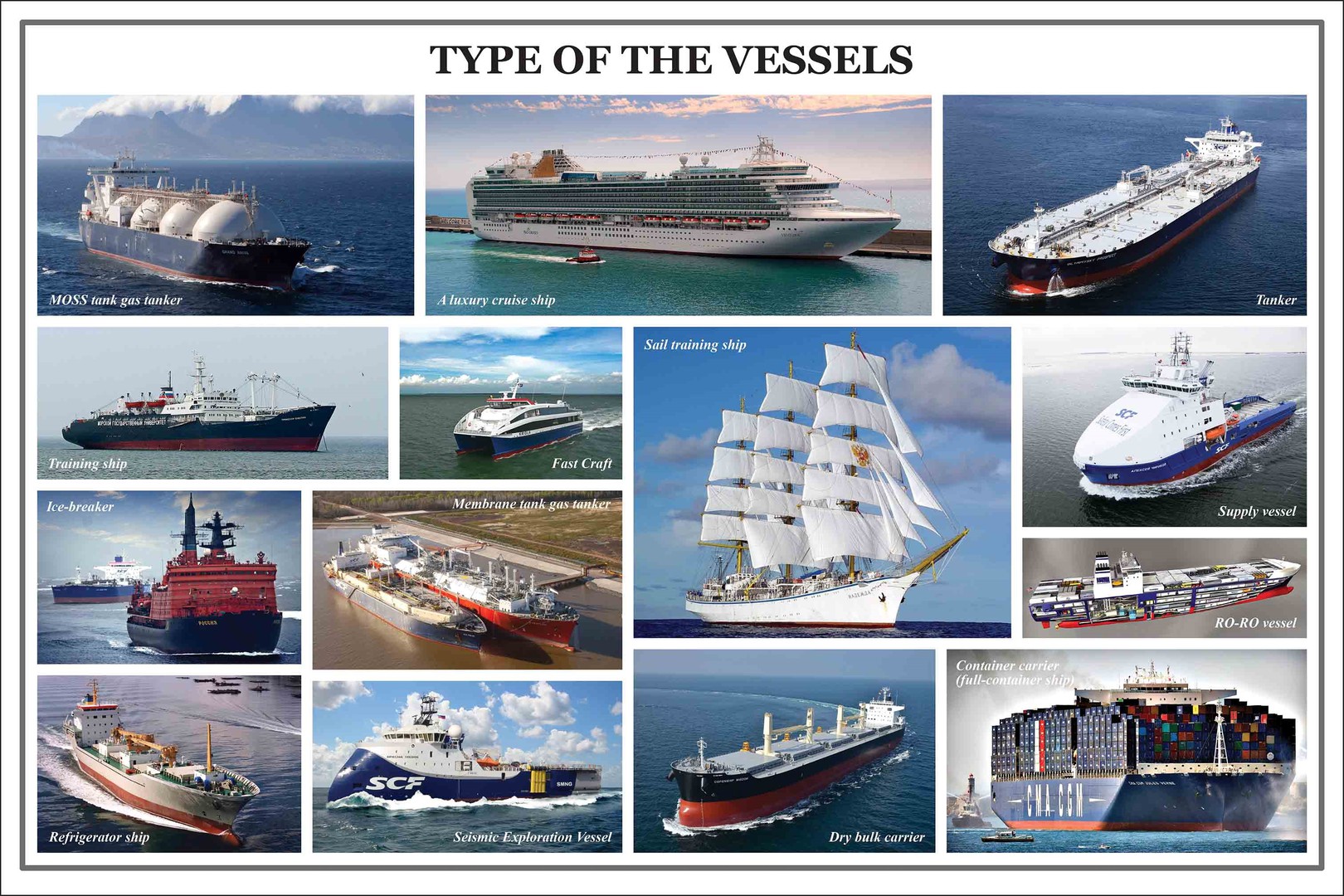- Position:
- 2nd engineer
Variety of types of water transport

Today, there are a huge number of cargo ships belonging to various categories. Their classification is based on many parameters, including purpose, dimensions, type of cargo carried, etc.
When designing commercial vessels, the economic factor is of primary importance. This is explained by the fact that each owner strives to get the maximum return on their own investment. That is why the design of commercial vessels depends not only on current economic needs. They are designed with the possibility of future adaptation in mind.
Ship design

A preliminary design of a vessel developed for further construction usually contains the following information about it:
- Dimensions
- Displacement
- Stability
- Engine characteristics
- Hull shape
- General layout
- Main design elements
The type of vessel plays an important role in determining the above parameters.
Further in the article, all existing categories of vessels, their subtypes and features will be considered in detail.
Main categories of vessels
Today, several key categories of vessels are distinguished:
- Container ships
- Offshore vessels
- Bulk carriers
- Warships
- Tankers
- Passenger vessels
- Refrigerated vessels
- Fishing vessels
- Special purpose vessels
Container ships

As the name suggests, a container ship is a cargo ship specially designed to carry large volumes of cargo packed in various types of containers.
Depending on their capacity, there are five types of container ships:
- Panama
- Suez
- Post-Panama
- Post-Suez
- Post-Malacca
Refrigerated container ships are worth mentioning separately.
These ships carry cargo that requires a special temperature regime, mainly in special containers - refrigerators.
Bulk carriers

A bulk carrier is a vessel designed to transport large volumes of cargo (usually dry cargo).
The cargo transported on a bulk carrier is bulk, i.e. it is placed in bulk, without any preliminary packaging.
Such commercial products as grain crops, metal ore, coal and even cement are transported by water in a similar manner.
The following types of bulk carriers are distinguished:
- conventional (designed for piece goods);
- with unloading equipment on board;
- without unloading equipment;
- combined;
- self-unloading;
- lakers;
- BIBO (an abbreviation for the English phrase "Bulk In, Bags Out") - allows you to pack the cargo in bag containers during unloading.
According to the type of cargo transported, bulk carriers are divided into five types:
- grain carriers;
- ore carriers;
- oil and ore carriers (dry cargo and liquid bulk carriers);
- cement carriers;
- universal.
Tankers

A tanker is a specialized vessel designed to transport large volumes of liquid (bulk) cargo. Tankers, in turn, are divided into several categories depending on the cargo being transported.
Let's look at the main types of tankers:
- Oil tankers.
They are mainly used to transport crude oil (raw oil) and its refined products (petroleum products).
- Chemical (chemical tankers).
This type allows you to transport chemicals.
- Gas tankers.
These are tankers for transporting gas in liquefied form. Gas tankers are designed to transport hydrocarbon, natural gas (LNG) or chemical gases.
- Other types.
These include vessels for transporting juice, wine, etc.
Depending on their size, tankers are further divided into the following classes:
- VLCC - large-tonnage;
- ULCC - supertankers;
- Panamax – designed to pass through the Panama Canal;
- Aframax – suitable for transporting oil by countries that are not members of OPEC;
- Suezmax – designed to pass through the Suez Canal;
- Capesize – large in size, not allowing passage through the Panama and Suez Canals;
- Handy – medium-displacement oil tankers;
- Handymax – heavy-displacement oil tankers;
- Lighters – lighters for delivering cargo to shore
Roll on / Roll off

This name comes from the abbreviation "Ro-Ro". It is an abbreviation of the English phrase "Roll-on / roll-off". Such a rolling vessel is used to transport cargo on a wheeled base.
The key feature of the considered group of dry cargo vessels is the horizontal loading and unloading of cargo, which occurs through a folding bow or stern.
Today, the following types of ro-ro vessels exist:
- Car carrier
this is a vessel for transporting cars, with its help they transport cars (PCC) and trucks (PCTC);
- ConRo
a hybrid version combining a container ship and a ro-ro;
- GenRo
a general-purpose ro-ro;
- RoPax
in addition to cargo, they are also capable of transporting a huge number of passengers, often equipped with a garage;
Passenger ships

As the name suggests, this type of ship is mainly used to transport passengers.
Most of them are divided into two types:
- Ferries
they are used to transport not only passengers but also their vehicles (cars) over relatively short distances.
- Cruise ships
are mainly intended for entertainment. They are luxurious floating hotels with the most modern amenities, making international voyages.
Passenger ships are further subdivided into:
- Canal ferries;
- Coastal ferries;
- Harbor ferries;
- Cruise ships;
- Pilgrimage ships;
- Arctic and Antarctic cruise ships.
Offshore vessels

Offshore vessels are mainly used for deep-sea oil exploration and offshore construction work. These are specialized vessels that help solve a wide range of tasks at sea.
Let's look at the main types of offshore vessels:
- Supply vessels.
They are used to service and supply offshore drilling rigs.
- Vessels for handling anchors.
This type of marine transport is used in construction and installation work in the open sea.
- Pipe-laying vessels.
Pipe-laying vessels specialize in underwater pipe and cable laying.
- Diving vessels.
They are used by divers when diving in the ocean and for underwater work.
- Crane barges or floating cranes.
Such vessels are equipped with a crane unit and are designed to lift heavy loads.
- Production platforms.
They are designed for oil production, gas production, oil refining and natural gas processing. They are also used for temporary storage of oil products and gas until they are delivered to shore for further processing or sale.
- Semi-submersible drilling rigs.
This is a mobile type of floating drilling rig. They are used to create stable platforms for oil and gas exploration and production, and to drill oil and gas wells.
- Drilling ships.
These are commercial vessels designed for offshore exploration drilling and scientific use. They are used to drill new oil and gas wells.
- Dormitory barges.
Such barges can act as an independent floating hotel or include, in addition to living quarters, non-residential space allocated for cargo placement.
- Floating storage unit (FSU).
Such floating storages are mainly used to store oil and its by-products.
- Floating production and storage unit (FPSO).
This type also plays the role of an unloading block. It is used in the offshore oil and gas industry - for the production and processing of hydrocarbons and storage of oil in the open sea.
Fishing vessels

Fishing vessels include vessels and boats used for recreational or commercial fishing at sea.
Fishing vessels are divided into:
- trawlers and non-trawlers;
- catching, processing and universal.
Specifically, in this category are distinguished:
Trawlers
- also known as draggers. They are commercial fishing vessels designed to work with trawls. Trawling is a method of fishing, which comes down to actively dragging or pulling the trawl behind itself by one or several trawlers at once.
Seiners
Equipped with a cast purse seine, which is a large wall of nets that unfolds around a certain water area or school of fish. The seine is equipped with floats along the upper line and a leader cord threaded through rings along the lower part. As soon as a school of fish is detected in the water, the boat immediately surrounds it with a net.
Floating factories,
also known as fish processing vessels. These floating bases are large ocean-going vessels with a wide range of onboard equipment. They are designed to process and freeze caught fish or whales. Such factories receive seafood from fishing vessels and then process it directly at sea.
General-purpose vessels.
They are part of any fishing fleet. Such a fishing vessel is capable of not only catching, but also independently processing the caught fish.
Specialized vessels

Special purpose vessels are built and operated for specific purposes
Classification by the nature of their activity:
- Tugs
A tugboat or tug boat is capable of maneuvering other vessels by pushing and towing. Rescue tugs are often found.
- Tenders
These are vessels for the delivery of crew and supplies. These include boats and larger vessels used to service and support other ships or boats. As a rule, tender vessels carry people and/or supplies.
- Pilot vessels
Used to transport harbor pilots.
- Cable-laying vessels
Designed for laying underwater cables. Cable-laying vessels help to lay cables of different types directly on the seabed.
- Research vessels
These are special vessels used for various studies at sea. The most common types of research vessels include seismic, hydrographic, oceanographic, polar, etc.
- Rescue vessels
They are engaged in rescue operations on the water, and are also used to search for, collect and return property lost at sea.
- Lightships
These are vessels that act as a lighthouse and emit light. They are used in waters that are unsuitable for the construction of conventional lighthouses due to too great a depth or for other reasons.
- Icebreakers
They are used to cut ice in extremely cold climates to ensure navigation.
- Barges
These are flat-bottomed boats, designed mainly for transporting heavy loads along rivers and canals. Another common name for them is barges.
- Livestock carriers
They refer to vessels for transporting livestock. They carry not only farm animals, but also other animals.
- Timber carriers
These are vessels for transporting timber, they transport timber.
High-speed vessels

This is a special type of technologically advanced and high-performance (usually high-speed) marine transport.
Although high-speed technologies are practically not used in commercial shipbuilding, some of them have been successfully implemented and tested on conventional small-sized vessels.
The main types of high-speed vessels are:
- hydrofoil vessels;
- multi-hull vessels, including breakwaters;
- ekranoplans;
- surface ships and high-speed hovercraft;
- double-hull vessels with a small cross-sectional area along the waterline.
Dredging vessels

Dredging is a special type of excavation work carried out underwater (usually in shallow coastal areas or in freshwater bodies of water) to collect bottom sediments and to widen the seabed.
Dredgers
- are vessels equipped with special earthmoving tools designed to remove sand and other types of sediment from the seabed.
Such dredgers with a working body - a dredging tool - are used for various purposes, including ensuring navigation in coastal shallow waters, deep-sea mining, etc.
Most dredgers are divided into two groups:
- Mechanical
- Hydraulic
- Position:
- Chief engineer
- Position:
- Electrician engineer
- Position:
- 2nd engineer
- Position:
- Electrician engineer
